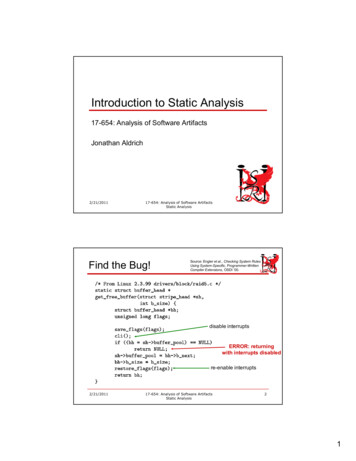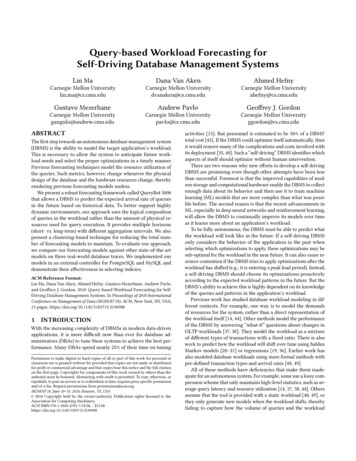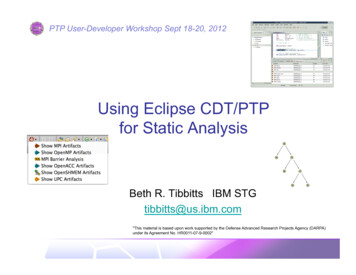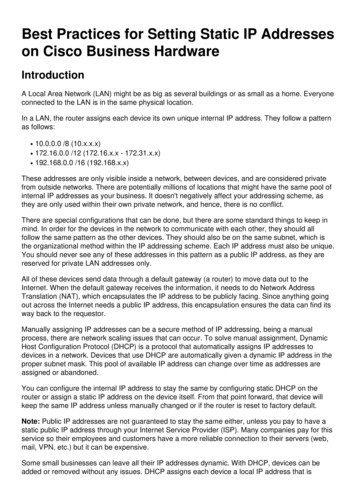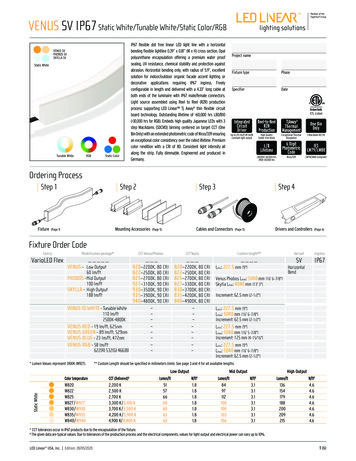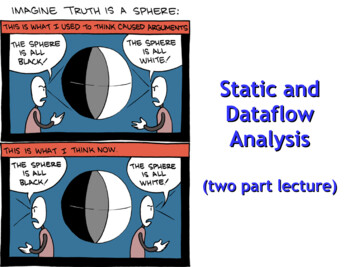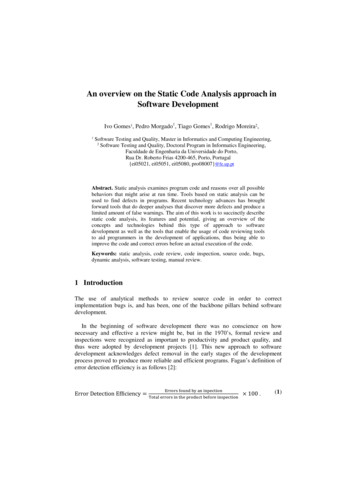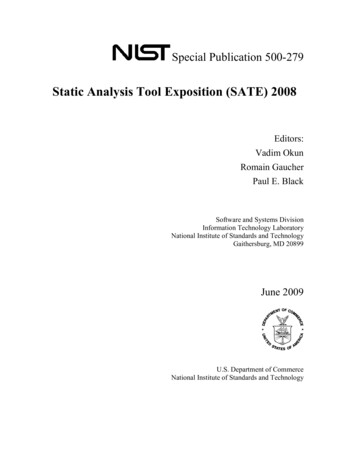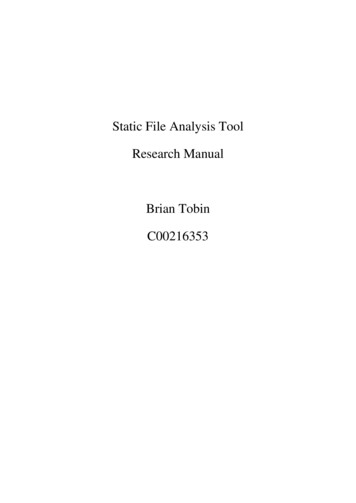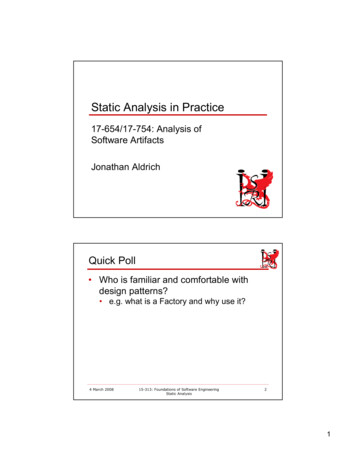
Transcription
Static Analysis in Practice17-654/17-754: Analysis ofSoftware ArtifactsJonathan Aldrich1Quick Poll Who is familiar and comfortable withdesign patterns? e.g. what is a Factory and why use it?4 March 200815-313: Foundations of Software EngineeringStatic Analysis21
Outline: Static Analysis in Practice Case study: Analysis at eBayCase study: Analysis at MicrosoftAnalysis Results and ProcessExample: Standard AnnotationLanguage Dataflow Analysis Soundness4 March 200815-313: Foundations of Software EngineeringStatic Analysis3Analyzing Tool Output True Positive – real issue The error condition warned about can occur at run time, forsome program inputTrue Positive – but don’t care That program input is impossible due to the system context False Positive e.g. security: attacker cannot control the input (are you sure?)The error condition is not one we care aboutThe error condition cannot occur at run time, no matter whatthe program input isTool project: must distinguish from true positive but don’t careFalse Negative The program can get into an error condition for an attributecovered by the tool for some input, but the tool does not warnof it4 March 200815-313: Foundations of Software EngineeringStatic Analysis42
Analysis Maturity ModelCaveat: not yet enough experience to make strong claims Level 1: use typed languages, ad-hoc tool use Level 2: run off-the-shelf tools as part of process pick and choose analyses which are most usefulLevel 3: integrate tools into process check in quality gates, milestone quality gatesintegrate into build process, developer environmentsuse annotations/settings to teach tool about internal libraries Level 4: customized analyses for company domain Level 5: continual optimization of analysisinfrastructure extend analysis tools to catch observed problemsmine patterns in bug reports for new analysesgather data on analysis effectivenesstune analysis based on observations4 March 200815-313: Foundations of Software EngineeringStatic Analysis5Static Analysis in Engineering Practice A tool with different tradeoffs Soundness: can find all errors in a given classFocus: mechanically following design rules Major impact at Microsoft and eBay Tuned to address company-specific problemsAffects every part of the engineering process4 March 200815-313: Foundations of Software EngineeringStatic Analysis63
Outline: Static Analysis in Practice Case study: Analysis at eBayCase study: Analysis at MicrosoftAnalysis Results and ProcessExample: Standard AnnotationLanguage Dataflow Analysis Soundness4 March 200815-313: Foundations of Software EngineeringStatic Analysis7Standard Annotation Language (SAL) A language for specifying contracts betweenfunctions Intended to be lightweight and practicalMore powerful—but less practical—contractssupported in systems like ESC/Java or Spec# Preconditions Conditions that hold on entry to a functionWhat a function expects of its callers Postconditions Conditions that hold on exiting a functionWhat a function promises to its callers Initial focus: memory usage buffer sizes, null pointers, memory allocation 4 March 200815-313: Foundations of Software EngineeringStatic Analysis84
SAL is checked using PREfast Lightweight analysis tool Only finds bugs within a single procedureAlso checks SAL annotations for consistency with codeTo use it (for free!) Download and install Microsoft Visual C 2005 ExpressEdition Download and install Microsoft Windows SDK for px?familyid c2b1e300-f358-4523-b479-f53d234cdccfUse the SDK compiler in Visual C 4 March 2008In Tools Options Projects and Solutions VC Directoriesadd C:\Program Files\Microsoft SDKs\Windows\v6.0\VC\Bin (orsimilar)In project Properties Configuration Properties C/C Command Line add /analyze as an additional option15-313: Foundations of Software EngineeringStatic Analysis9Demonstration: PREfast4 March 200815-313: Foundations of Software EngineeringStatic Analysis105
Buffer/Pointer Annotations Format Leading underscore List of components belowinThe function reads from the buffer. The callerprovides the buffer and initializes it.The function both reads from and writes to buffer.The caller provides the buffer and initializes it.The function writes to the buffer. If used on thereturn value, the function provides the bufferand initializes it. Otherwise, the caller providesthe buffer and the function initializes it.inoutoutbcount(size)ecount(size)The buffer size is in bytes.The buffer size is in elements.optThis parameter can be NULL.4 March 200815-313: Foundations of Software EngineeringStatic Analysis11PREfast: Immediate Checks Library function usage deprecated functions correct use of printf e.g. gets() vulnerable to buffer overrunse.g. does the format string match the parameter types?result types e.g. using macros to test HRESULTs Coding errors instead of inside an if statement Local memory errors Assuming malloc returns non-zeroArray out of bounds4 March 200815-313: Foundations of Software EngineeringStatic Analysis126
Other Useful AnnotationsCallers must check the return value.checkReturn .Net Annotation Format Pre/Post attribute with arguments forthe pre or postconditionSurrounded in bracketsAlternative for the annotations aboveRequired for Tainted[SA Pre(Tainted SA Yes)]This argument is tainted and cannot be trustedwithout validation.[SA Pre(Tainted SA No)]This argument is not tainted and can be trusted[SA Post(Tainted SA No)]Same as above, but useful as a postcondition4 March 200815-313: Foundations of Software EngineeringStatic Analysis13Other Supported Annotations How to test if this function succeededHow much of the buffer is initialized?Is a string null-terminated?Is an argument reserved?Is this an overriding method?Is this function a callback?Is this used as a format string?What resources might this function block on?Is this a fallthrough case in a switch?4 March 200815-313: Foundations of Software EngineeringStatic Analysis147
SAL: the Benefit of Annotations Annotations express design intent How you intended to achieve a particular quality attribute As you add more annotations, you find more errors Get checking of library users for freePlus, those errors are less likely to be false positives e.g. never writing more than N elements to this arrayThe analysis doesn’t have to guess your intentionAnnotations also improve scalability PreFAST uses very sophisticated analysis techniquesThese techniques can’t be run on large programsAnnotations isolate functions so they can be analyzed one ata time4 March 200815-313: Foundations of Software EngineeringStatic Analysis15SAL: the Benefit of Annotations How to motivate developers? Especially for millions of lines of unannotated code?Microsoft approach Require annotations at checkin Make annotations natural Ideally what you would put in a comment anyway But now machine checkableAvoid formality with poor match to engineering practicesIncrementality Reject code that has a char* with no ecount()Check code design consistency on every compileRewards programmers for each increment of effort Provide benefit for annotating partial codeCan focus on most important parts of the code firstAvoid excuse: I’ll do it after the deadlineBuild tools to infer annotations Inference is approximate Unfortunately not yet available outside Microsoft4 March 2008 May need to change annotationsHopefully saves work overall15-313: Foundations of Software EngineeringStatic Analysis168
Case Study: SALinfer[Source:Manuvir Das]void work(){int elements[200];wrap(elements, 200);}Track flow of values through the codevoid wrap(prewrap(elementCount(len) int *buf,int len){int *buf2 buf;int len2 len;zero(buf2, len2);}1.2.3.4.Finds stack bufferAdds annotationFinds assignmentsAdds annotationvoid zero(zero(pre elementCount(len) int *buf,int len){int i;for(i 0; i len; i )buf[i] 0;}4 March 200815-313: Foundations of Software EngineeringStatic AnalysisCase Study: SAL verification17[Source:Manuvir Das]void work(){int elements[200];wrap(elements, 200);}Building and solving constraintsvoid wrap(pre elementCount(len) int *buf,int len){int *buf2 buf;int len2 len;zero(buf2, len2);}void zero(pre elementCount(len) int *buf,int len){int i;for(i 0; i len; i )buf[i] 0;}1.2.3.Builds constraintsVerifies contractBuilds constraintslen length(buf); i len4.Finds overruni length(buf) ? NO!Limited tool available as part of Microsoft Visual Studio 20054 March 200815-313: Foundations of Software EngineeringStatic Analysis189
Outline: Static Analysis in Practice Case study: Analysis at eBayCase study: Analysis at MicrosoftAnalysis Results and ProcessExample: Standard AnnotationLanguage Dataflow Analysis Soundness4 March 200815-313: Foundations of Software EngineeringStatic Analysis19Dataflow Analysis Soundness Intuition The result of dataflow analysis is a conservativeapproximation of all possible run time states Definition A dataflow analysis is sound if, for all programs P,for all inputs I, for all times T in P’s execution oninput I,If P is at statement S at time T, with memory η,and the analysis returned abstract state σ for S,then α(η) σ4 March 200815-313: Foundations of Software EngineeringStatic Analysis2010
Local SoundnessαDF(ηi) σiƒDF(σi, S)σo αDF(ηo)αDFηi S ηoLocal correctness condition for dataflow analysis αDFIf applying a transfer function to statement S and input informationσi yields output information σo,Then for all program states ηi such that α(ηi) σi and executing Sin state ηi yields state ηo,We must have α(ηo) σoGlobal soundness follows from local soundness by induction Initial dataflow facts are soundEach step in program execution maintains soundness invariant4 March 200815-313: Foundations of Software EngineeringStatic Analysis21Finding Errors with Local Soundness Consider the incorrectflow function:ƒZA(σ, [x : y op z]) if σ[y] Z σ[z] Zthen [x Z]σelse [x MZ]σ ƒDF(σi, S)σo αDF(ηo)αDF(ηi) σiαDFηiαDFS ηoLocal Soundness fails! Let σi [], S “x : 3 0”Consider ηi []. As required, αDF(ηi) [] σiNow σo ƒDF(σi, S) [x Z]And ηo S(ηi) [x 3]So αDF(ηo) αDF([x 3]) [x NZ]BUT αDF(ηo) σo because Z NZ, so local soundness is violated4 March 200815-313: Foundations of Software EngineeringStatic Analysis2211
Why care about Soundness? Analysis Producers Writing analyses is hard People make mistakes all the time Need to know how to think about correctness When the analysis gets tricky, it’s useful to prove it correctformally Analysis Consumers Sound analysis provides guarantees Optimizations won’t break the program Finds all defects of a certain sort Decision making Knowledge of soundness techniques lets you ask the rightquestions about a tool you are considering Soundness affects where you invest QA resources Focus testing efforts on areas where you don’t have a soundanalysis!4 March 200815-313: Foundations of Software EngineeringStatic Analysis23Questions?4 March 200815-313: Foundations of Software EngineeringStatic Analysis2412
Static Analysis 6 Static Analysis in Engineering Practice A tool with different tradeoffs Soundness: can find all errors in a given class Focus: mechanically following design rules Major impact at Microsoft and eBay Tuned to address company-specific problems Affects every part of the engineering process

